Functional traits and phylogeny explain snake distribution in the world's largest dry forest ecoregion, the Gran Chaco
Compartir
Registro completo
Mostrar el registro completo del ítemFecha de publicación
2022-11-15Tipo de publicación
info:eu-repo/semantics/articleMateria(s)
Climate
Ecology
Habitat heterogeneity
Macroecology
Morphology
Phylogenetic region
Soil conditions
Species traits
Ecology
Habitat heterogeneity
Macroecology
Morphology
Phylogenetic region
Soil conditions
Species traits
Resumen
Macroecological studies describe large-scale diversity patterns through analyses of species distribution patterns and allows us to elucidate how species differing in ecology, physical requirements, and life histories are distributed in a multidimensional space. These patterns of distributions can be explained by vegetation, and climatic factors, and are determined by historical and current factors. The continuous accumulation of information on the distribution patterns of species is essential to understand the history and evolution of the biota. In this study, we aimed to identify functional and evolutionary drivers that explain the geographic patterns of vertical stratification. We compiled morphological, ecological, and distribution data of 140 species of Chacoan snakes and constructed null models to map their geographic pattern. We used a range of environmental variables to assess which drivers are influencing these biogeographic patterns. Lastly, we used evolutionary data to build the first map of the phylogenetic regions of Chacoan snakes. We found a latitudinal pattern, with a marked verticality in the snake assemblies in the Chaco. Verticality and long-tailed species richness increased in areas with high stratified habitats and stable temperature. Fossoriality is driven mainly by soil conditions, especially soils with fewer sand particles and less stratified habitat. Phylogenetic regions in the Chaco showed a marked latitudinal pattern, like that observed in the geographic pattern of verticality. The distribution pattern of Chacoan snakes also reflects their evolutionary history, with a marked phylogenetic regionalization.







